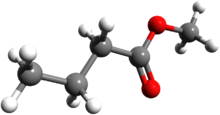| Revision as of 14:47, 22 February 2018 editEdgar181 (talk | contribs)Extended confirmed users196,325 editsNo edit summary← Previous edit | Revision as of 18:03, 31 December 2018 edit undoJWBE (talk | contribs)Extended confirmed users10,129 edits removed Category:Butyrates; added Category:Butyrate esters using HotCatNext edit → | ||
| Line 57: | Line 57: | ||
| {{Esters}} | {{Esters}} | ||
| ] | ] | ||
| ] | ] | ||
| ] | ] | ||
| ] | ] | ||
Revision as of 18:03, 31 December 2018
Not to be confused with 2-methylbutyrate or 3-methylbutyrate. | |
 | |
| Names | |
|---|---|
| Preferred IUPAC name Methyl butanoate | |
| Other names
Butanoic acid methyl ester Methyl butyrate Butyric acid methyl ester | |
| Identifiers | |
| CAS Number | |
| 3D model (JSmol) | |
| ChemSpider | |
| ECHA InfoCard | 100.009.812 |
| EC Number |
|
| MeSH | C043811 |
| PubChem CID | |
| RTECS number |
|
| CompTox Dashboard (EPA) | |
InChI
| |
SMILES
| |
| Properties | |
| Chemical formula | C5H10O2 |
| Molar mass | 102.133 g·mol |
| Appearance | Colorless liquid |
| Density | 0.898 g/cm |
| Melting point | −95 °C (−139 °F; 178 K) |
| Boiling point | 102 °C (216 °F; 375 K) |
| Solubility in water | 1.5 g/100 mL (22 °C) |
| Magnetic susceptibility (χ) | −66.4×10 cm/mol |
| Refractive index (nD) | 1.386 |
| Hazards | |
| NFPA 704 (fire diamond) |
 |
| Flash point | 12 °C (54 °F; 285 K) |
| Except where otherwise noted, data are given for materials in their standard state (at 25 °C , 100 kPa).
| |
Methyl butyrate, also known under the systematic name methyl butanoate, is the methyl ester of butyric acid. Like most esters, it has a fruity odor, in this case resembling apples or pineapples. At room temperature, it is a colorless liquid with low solubility in water, upon which it floats to form an oily layer. Although it is flammable, it has a relatively low vapor pressure (40 mmHg at 30 °C (86 °F)), so it can be safely handled at room temperature without special safety precautions.
Methyl butyrate is present in small amounts in several plant products, especially pineapple oil. It can be produced by distillation from essential oils of vegetable origin, but is also manufactured on a small scale for use in perfumes and as a food flavoring.
Methyl butyrate has been used in combustion studies as a surrogate fuel for the larger fatty acid methyl esters found in biodiesel. However, studies have shown that, due to its short-chain length, methyl butyrate does not reproduce well the negative temperature coefficient (NTC) behaviour and early CO2 formation characteristics of real biodiesel fuels. Therefore, methyl butyrate is not a suitable surrogate fuel for biodiesel combustion studies.
References
- Merck Index, 13th Edition
- Methyl butyrate, thegoodscentscompany.com
- Aldrich Chemicals Handbook, Sigma-Aldrich Company, Milwaukee, (2007)
- Flath, Robert A.; Forrey, R. R. (1970). "Volatile components of Smooth Cayenne pineapple". Journal of Agricultural and Food Chemistry. 18 (2): 306–309. doi:10.1021/jf60168a018.
- Use of methyl butyrate as an additive in perfume Archived 2008-05-31 at the Wayback Machine
- Methyl butyrate as a component of biodiesel Archived March 6, 2006, at the Wayback Machine
- Gaïl, S.; Thomson, M.J.; Sarathy, S.M.; Syed, S.A.; Dagaut, P.; Diévart, P.; Marchese, A.J.; Dryer, F.L. (2007). "A wide-ranging kinetic modeling study of methyl butanoate combustion". Proceedings of the Combustion Institute. 31: 305. doi:10.1016/j.proci.2006.08.051.
| Esters | |
|---|---|
| Methyl esters | |
| Ethyl esters | |
| Propyl esters | |
| Butyl esters | |
| Amyl esters | |
| Hexyl esters | |
| Phenyl esters | |
| Heptyl esters | |
| Benzyl esters | |